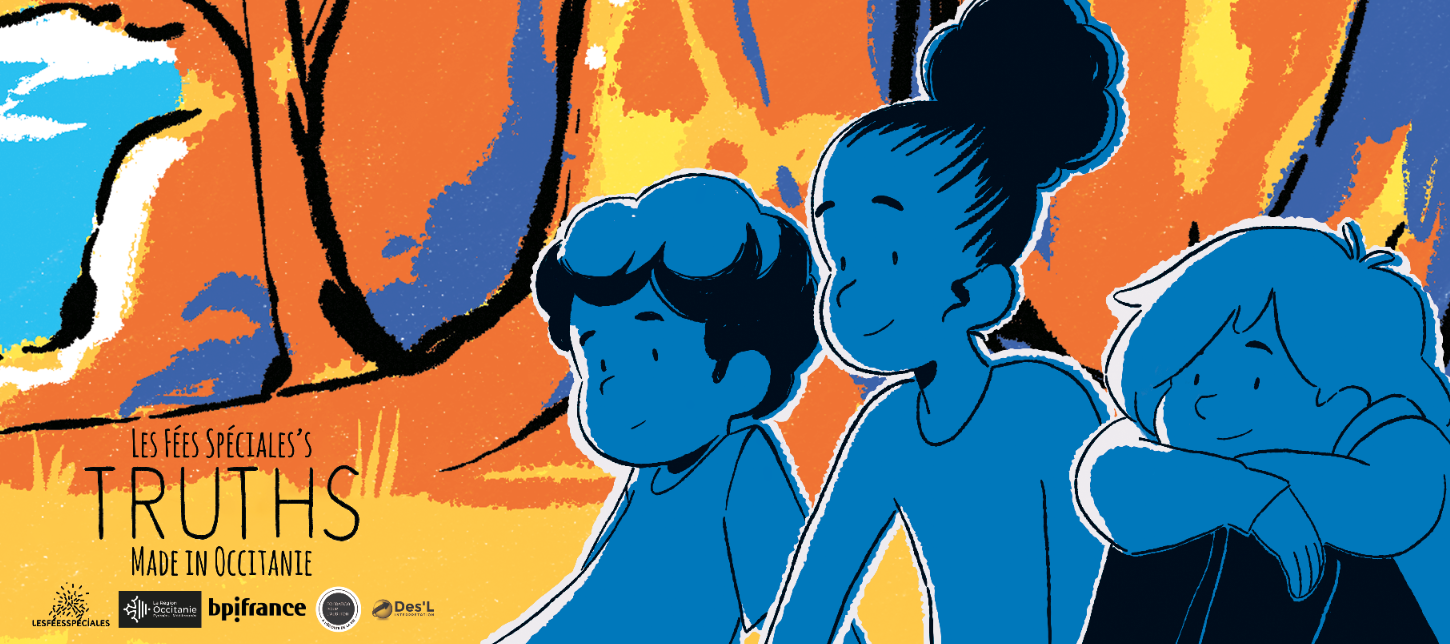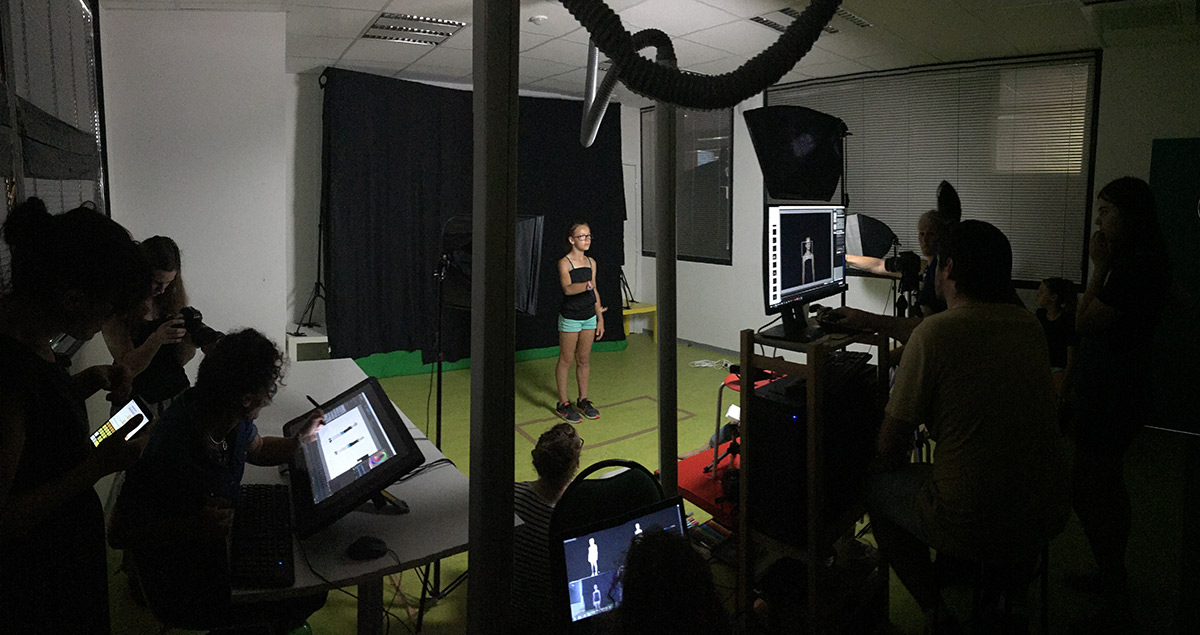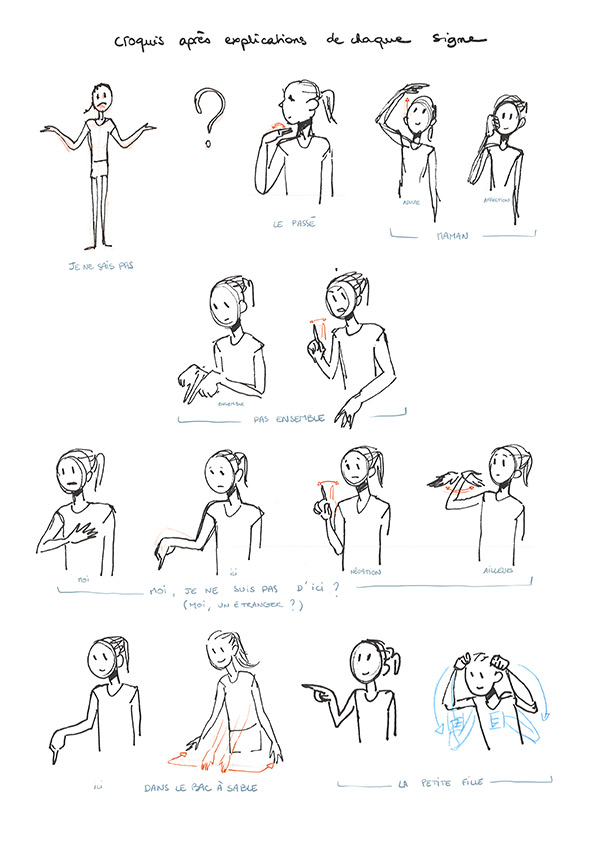
This year we produced a 2-minute pilot episode using Blender 2.8 and the Grease Pencil. It’s our company Les Fées Spéciales’ first production in its own name, and we presented it last september in the biggest European pitching platform, the Cartoon Forum. In this article we cover where this project comes from and why we are doing it; how we switched to the Grease Pencil to handle the production process and what the future of the project is. We are thrilled to be able to talk about it.
Note that for a change, it’s not really a technical article, but more of a production making-of of that pilot.
Where is this coming from?
A few years ago, while establishing the studio as a cooperative, we met other cooperatives in the area. Among them, Des’L, composed of professional French sign language interpreters for deaf people. Carlos Carreras, then CEO, introduced us to Antonio Rodriguez Yusts, a painter and poet. Together they formed the Collectif deux poings (Two fists collective), where they used the sign language in theatrical performances. They were very strong and visual performances with an amazing use of body language, which was jaw-dropping for the animators we are.
Speaking with them, we soon realised that watching animated movies for deaf kids under 12 was very hard, because of the speed of the subtitles. Such kids often need their parents to explain the movies to them. That leads to a difference between kids who are able or unable to follow such programs. And such a difference creates even more isolation for deaf children. So we wondered: what can we do about it? Can we create a story with dialogues, that anyone, deaf and non-deaf, can watch together?
It took us a long process in writing, understanding, adapting our story ideas. We worked with Marie Lamoth and the amazing people from Des’L, an interpreting company, but also with deaf kids, from Paul Blet School of Poitiers (France) and with the deaf actor and theatre director Anthony Guyon, to give shape to the project. Even if some ideas might look good for us, they might not work for the deaf. For example something based on a play on words could be too complicated to translate. It’s harder than we think to find humour, jokes and situations shared between cultures. We found many issues to get a concept that is production-valid and that could really exist.
For example, one of the first things was to create a character that signs, but not in French sign language (LSF). Because such a choice would mean the impossibility to distribute the project abroad (or it would require to remake the animations country by country, with their own sign language). So we worked with Anthony Guyon, Marie Lamoth, and also translators from Vice versa Company and even an improvisational theatre company to make a more universal sign language (not based on the proposed Universal Sign Language either, the equivalent of Esperanto). Even though it’s not strongly present in the pilot (because of editing choices and objectives), it’s an important constraint for the conception and writing of the series.

Other difficulties might include: how many drawings are needed to get a sign to be understandable? Or can we even do it right in a 2D style while sign language is a body space language?

We did a week-long workshop with the interpreters, comedians and deaf kids, trying many recording techniques and working to find the lowest common denominator for those questions.
If you are interested in knowing more, let me know in the comments.
The point is that we decided to go further and aim for a 2D animated TV series. And as of today, we aim for a 26 × 7 minutes series, 182 minutes of content.
Getting up to date
Les Fées Speciales as a company uses various media, but mostly works in 3D (with Blender of course). But this project required real 2D animation. Blender 2.8 was on sight, including the new Grease Pencil.
With help from the CNC (French cinema agency), we started working on a 2D workflow. Part of that included training our team to the use of Blender 2.8 and the Grease Pencil. So we invited Daniel Martinez Lara to join us for the training. Our artists and technicians were here, learning the workflow, discovering the new ways of creating content. Having Daniel visiting the studio helped us kickstart everything.

For some time, our head of animation and director of the series, as well as other members of the future project, did many tests to challenge the workflow and we reported many bugs to Daniel back then. At the same time, we finalised some editorial choices for the creation of the pilot so the production could start.
Making a pilot
While the design was handled by Léa Cluzel, creative director, Marthe Delaporte started storyboarding and making an animatic directly in Blender with the Grease Pencil. This is a powerful feature, because you can already have a pre-layout from the animatic stage, including the cameras and timings.
The production was pretty standard from there:
- We create the sets from the layout in Krita
- A rough blocking animation is done
- Clean animation follows if the staging and timing are good
- We do an ink pass (cleaning the line)
- And the painting / colour process is done at the end

Daniel Martinez Lara was invited once again during the production so we could make specific feedback after some weeks of work, explaining what was delaying us, or the tricks we found to work with the Grease Pencil. And according to our workflow and to the project style, Daniel provided cool tricks to work with too.
We also used 3D cameras for some shots, and our Rigify-based puppet rig, updated for Blender 2.8 and using Grease Pencil layers this time for the sequence in “space”. It’s clear that the mix of techniques is a killer feature for Blender 2.8, as we can do everything in the same program with very advanced features. Kudos to everyone involved in Blender and Grease Pencil, you are making this project possible!
As for the render it was done with the usual render layers and assembled using a mix of Blender for precomp and Blackmagic’s Fusion for the final compositing. Guilhem Garcin, the co-director, was in charge.
Some struggles?
Of course, everything did not go smoothly. It was early 2019, and Blender 2.8 was still in alpha/beta. For example, for some reason, on the very same machines and OS (Linux Mint) the same Blender build would not behave the same, and we had to change computers until we found a stable one. Things were crashing, options were disabled, etc. It was a beta after all. And it was clearly improving build after build during the production.
The colour workflow was long and tedious for the artists. It quickly made the shots pretty heavy just because of the strokes. It is not perfect yet and we hope to get involved in improving it in the future.
Where do we go from here?
Truths is the first in-house production of the company Les Fées Spéciales. We were in Toulouse in september, attending the Cartoon Forum, Europe’s biggest co-production platform, where producers pitch their new projects to find investors and interested partners. We presented the pilot and the universe of the future TV series and got good feedback and contacts for the future. We had a nice press review including a sneak peek by Cartoon Brew.
During the next few months, the production will be working on developing the writing process before looking for funds. It’s a new adventure which might now take years to conclude as a real production.
Will other studios join the production? Using Blender? Will we be able to upscale the creation of the universal signs for almost 3 hours of content? And of course, are we going to find the funds to produce it? That might be the subject of a future article. In the meantime, you can have a look at the pilot below. Thanks for reading and let us know what you think.
3 Comments
Tamires Nascimento Pereira
Hello, my name is Tamires. Your project is amazing!
I read your article and I remembered a project in animation to teach deaf kids the sign language, here in Brazil, called: “Min e as maozinhas” (Min and the little hands). Take a look at YouTube: https://www.youtube.com/watch?v=zNCczm3jzgo&t=12s
Rafael Arame
The process for creating this project is really amazing. Congratulations!
As soon as I saw “Truth” I also remembered the Brazilian project “Min e as mãozinhas”(Min and the little hands):
https://www.youtube.com/channel/UCJtOTvG4EvBGkvtTVVv8Lpg/videos
Flavio Perez
Hi Tamires and Rafael!
Thanks for your feedback. We will definietly have a look to Min e as mãozinhas. I dont think the team knows it. It’s always interesting to see what was done in this field.
Thanks again for the reference, we glad you enjoyed our project!